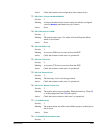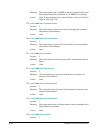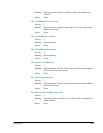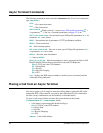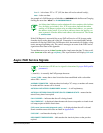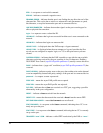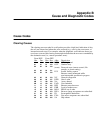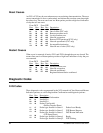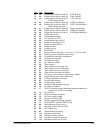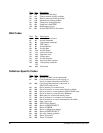
Async Terminal Operations A-3
D
or
P
– is the letter “D” or “P” (if P, the data will not be echoed locally),
data
– is the user data.
An example of a Call Request to called address
1000000000
with the Reverse Charging
facility plus user data “
abcde
” is:
R-1000000000Dabcde
An Abbreviated Address can be substituted for the complete called address
if no facilities are included. Also, X.28 convention demands that when
sending a Call Request packet using an abbreviated address, you precede
the address with a period. If you want to add user data to the packet, you
must separate it from the abbreviated address with an asterisk. The format
is:
.address*data
If the Call Request is successful, the async PAD will receive a Call Accept packet
from the device at the other end of the call. Connection is now established, and the
terminal will display COM. If the Call Request fails, the terminal will display a diag-
nostic message explaining why. The various messages are some of the PAD service
signals described later in this appendix.
To send data once you are in
Data Transfer
mode, simply enter the data. To clear a call,
enter
Command
mode and type
clr [Enter]
. The async terminal will display:
CLR conf
.
Async PAD Service Signals
Transmission of PAD service signals is determined by async PAD profile
parameter 6.
*
(Asterisk) – is normally the PAD prompt character.
“nnnnn” COM
– means that a vitual circuit has been established with a subscriber
whose ID is
“nnnnn.”
ALREADY CONNECTED
– indicates there is already a VC set up, so another call cannot
be made until the current call is cleared.
AUTOCALL INITIATED BY SUBSCRIBER “nnnmm”
– is self-explanatory.
AUTOCALL RETRIES EXHAUSTED-RETURN TO COMMAND STATE
– means that the
autocall retry timer has expired.
CALL CLEARED
– indicates that the call is being cleared.
CALL TIMED OUT
– is displayed when the network does not respond to a virtual circuit
call setup request within a certain time.
CLR (cause) (cause code) (diagnostic code)
– is displayed when the call is cleared.
Some common causes and codes are listed in Appendix B.
CLR CONF
– confirms the clearing of a call.
DISCONNECT TIMER EXPIRED
– indicates that the inactivity timer on the port has
expired.



